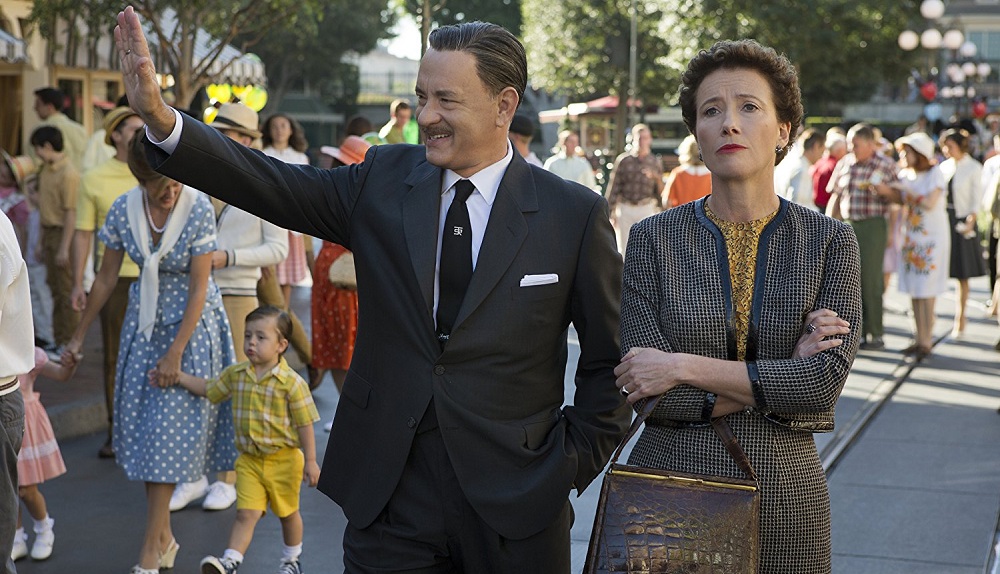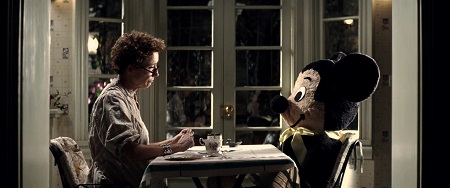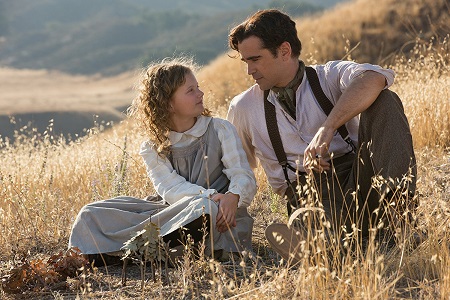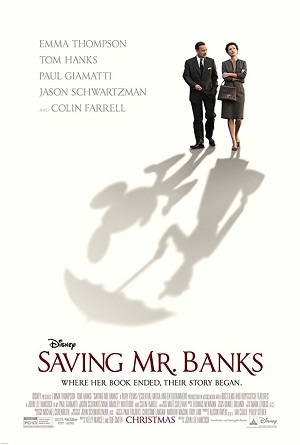
Jolly Mr. Banks a Charming Glance Behind Disney’s Curtain
For two decades, Walt Disney (Tom Hanks) has been trying to wrestle the film rights to her popular Mary Poppins series of books from author P.L. Travers (Emma Thompson). With money troubles making things increasingly a hardship, the fearful writer, certain the cartoon impresario will transform her beloved heroine into something she will abhor, flies to Hollywood to meet with the studio head in person. She is presented with a script and assaulted with songs she doesn’t find appropriate to the source material, Travers and Disney matching wits and butting heads as they try to sort out their differences, discovering the seeds of familial dysfunction and tragedy that led to the blossoming of a literary inspiration children of all ages have treasured for generations untold in the process.
Using the massive Disney vaults for inspiration, Saving Mr. Banks charts the ins and outs of a 1961 meeting of minds that would ultimately lead to the production of one of the studio’s most cherished productions, their 1964 Academy Award-winning classic Mary Poppins. Screenwriters Kelly Marcel and Sue Smith use the information stored by the Hollywood studio in their historical archives to craft a plot revolving around the two weeks Travers spent working with Walt, writer Don DaGradi (Bradley Whitford) and songwriters Richard (Jason Schwartzman) and Robert Sherman (B.J. Novak) on the motion picture as she contemplates whether or not to sign over rights to the character to the Hollywood studio. Intermixed inside that tale are flashbacks to her Australian childhood, her relationship to her doting, alcoholic banker father Travers Goff (Colin Farrell) deduced to be the inspiration behind the best-selling books she would eventually pen.
The movie isn’t as imaginative as either Travers’ writings or the live action-animation hybrid which they inspired. This is not a surprise. But as a whimsically audacious drama about how a motion picture masterpiece came to life, about the real people who worked, sometimes at cross-purposes, to stay true to what they believed to be the most important themes found within the source material, the movie is honestly kind of wonderful. Not perfect, mind you, not supercalifragalistic….well, you know the rest…but wonderful all the same, this look behind Disney’s curtain a thoroughly entertaining enterprise worth flying kites to the highest heights in order to see.
Playful hyperbole aside, director John Lee Hancock (The Blind Side) has done a nice job here, balancing the more melodramatic bits, mostly the stuff revolving around Goff and his twinkly-eyed daughter in the Australian outback, with the more authentically emotional beats with ease. He allows the relationship between Travers and Disney to blossom and grow without any extra padding, refusing to layer on saccharine or syrup when it would have been very easy to do just that. All of the pieces revolving around her visit to the Hollywood studio, working with the Sherman brothers and butting heads with DaGradi come home to roost with unobtrusive authenticity, bits of introspective, thoughtful magic filtering through at the most unexpected of moments.
Another reason all of this ends up working as well as it does is entirely due to the strength of the supporting performances. Not just the ones from Farrell, Whitford, Schwartzman and Novak, but also those delivered by fellow supporting players Paul Giamatti (as Travers’ gregarious limo driver), Kathy Baker (Disney’s highly trusted secretary Tommie), newcomer Annie Rose Buckley (Travers’ younger self, nicknamed Ginty) and Melanie Paxson (Disney’s flustered assistant Dolly). Each of them, especially Farrell, have a grand time diving into their respective roles, all bringing their all as they attempt to make this movie something more than just a reasonably enjoyable cinematic history lesson.
But the reason to see this movie, why it ends up mattering as much as it ultimately does, is entirely due to Thompson and Hanks. Neither look or sound like their historical counterpart. Yet somehow, someway both manage to disappear inside their respective role. Thompson, in particular, is genius, her performance a slow burn of angst, apprehension, creativity and protectionism, the intelligent woman hiding secrets she’d rather the world not be made aware of. Her transformation isn’t an obvious one, doesn’t contain any overdramatic flourishes, everything building to a few delicate moments of quiet retrospection and catharsis that’s as sublime as it is compelling.
In some ways, Hanks has an even more difficult challenge. Portraying one of the 20th century’s most iconic personalities, there is so much footage of Walt Disney kids born in 2013 will likely know this historical figure by sight within a few years of this review’s publication. Somehow the two-time Academy Award winner, who already gave one of his greatest performances in October’s Captain Phillips, does it again as Disney, his multifaceted, intricately balanced portrait full of continuous wonders. He’s excellent, a scene near the end inside Travers’ London home so compelling it manages to bring all of the film’s themes to life with emotionally ebullient ease.
Saving Mr. Banks can feel a little minor, and there are some annoying focus and pacing issues that keep it from ever sniffing greatness. Rachel Griffiths is wasted in a central role that that should have been far more integral to the story being told, while veteran composer Thomas Newman’s (Side Effects) Sherman-sampling score alternates between brilliance and tediousness, sometimes both at the same time. But Hancock’s direction is confident and assured, the filmmaker rarely allowing the picture to go astray or meander into corners it shouldn’t be examining. Coupled with the greatness of the performances, these facets help make the movie an entertaining jolly holiday I’m quite happy I took the time out of my own busy schedule to experience.
– Review reprinted courtesy of the SGN in Seattle
Film Rating: 3 (out of 4)








